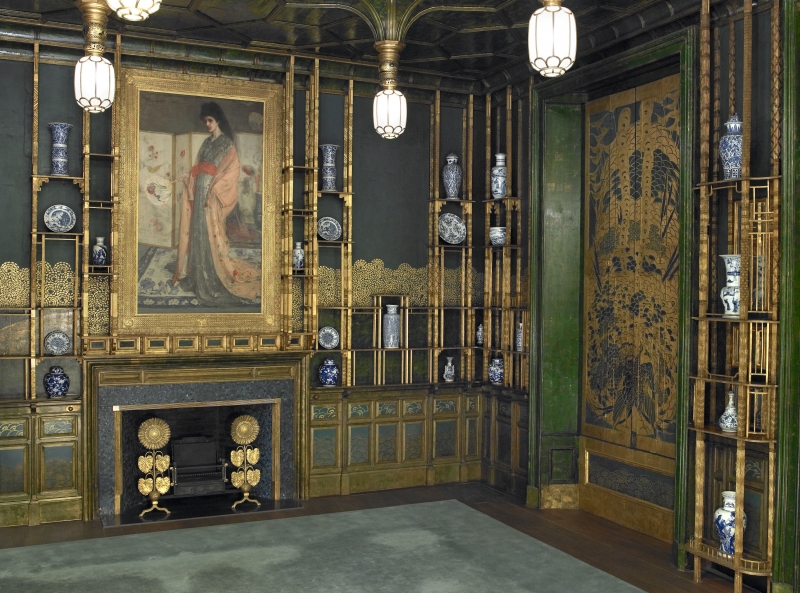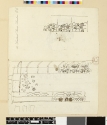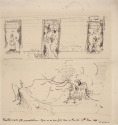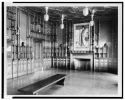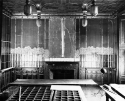Home > Catalogue > Browse > Harmony in Blue and Gold: The Peacock Room << >>
Composition
The panel The Rich Peacock and the Poor Peacock was installed on the south wall of the room. Susan Hobbs has pointed out that Whistler probably used a drawing of fighting peacocks from the recently published Keramic Art of Japan as the basis for his own composition. 1
There are pen drawings by Whistler that relate to this panel in several collections: the Hunterian, the British Museum, and in the Avery Collection, New York Public Library (see Three Peacock shutters [M.0580]).
The full-scale Cartoon of rich and poor Peacocks [M.0584] was pricked for transfer. It shows numerous pentimenti in chalk and wash, and is, in itself, a vigorous and striking drawing, unique in Whistler's oeuvre.
The drawings for the shutters in the Hunterian and the Avery Collection (Three Peacock shutters [M.0580] and Fighting Peacocks [M.0581]) and the Isabella Stewart Gardner Museum, have been considered later than the painted decorations. 2
Several drawings were given to Isabella Stewart Gardner (1840-1924) and are in the Isabella Stewart Gardner Museum in Boston (The walls of the Peacock Room [M.0989], Window in the Peacock Room [M.0990], and Peacock shutters [M.0991]). These drawings, according to the American artist Robert Goodloe Harper Pennington (1854 or 1855-d. 1920), were drawn eight years after the completion of the room. 3 None of these pen drawings show any marked differences from the completed panel; it is possible that they were all done from memory.
However, the drawings in the Avery Collection and Gardner Museum for the central shutter both show the butterfly on a semi-circular field, radiating light: and in the latter, the right-hand peacock has its wings much more outspread, cutting across the vertical space between the peacocks. In the drawing for the left-hand shutter in the Avery Collection, the peacock's feathers extend to the edge of the shutter on the left except at the upper left corner. Furthermore, the pen drawings for the side panels, in the Gardner Museum, may indicate that Whistler had an idea of inserting fully opened peacock tails in the panels above the dado.
A pencil Sketch of the Peacock Room [M.1581]), according to a signed inscription by the artist Albert Ludovici, Jr (1852-1932), was drawn by Whistler on 17 December 1893 'to give me an idea of it.' 4
Technique
Whistler's decoration was applied to the leather wall hangings. Linda Merrill has identified the leather as Dutch gilt leather from ca 1770, showing spiraling ribbons of roses and other summer flowers painted upon a lustrous surface. 5
Whistler had several assistants, including Matthew Robinson Elden (1839-1885), and probably Henry Greaves (1843-1904) and Walter Greaves (1846-1930), and tradesmen including 'Dick', who may have been Richard Watson, carver and gilder, of 146 Wardour Street, London, or Richard Annis, carver and gilder; of 36 Holland Street. A letter from Whistler to Elden indicates that he was temporarily in charge of works:
'Pray see that Dick repairs and gilds the one or two little places on the ceiling - all ready for me to retouch directly I return -
The Groinings in the ceiling must by this time be all gilt and varnished -
They can then go right on with the dado in the same Dutch Metal, begin[n]ing by the door and going round by the fire place -
The carved pillars are to be gilded all right and they might put in a couple on each side of the picture.' 6
Jeckyll suffered from a mental breakdown, which brought work to a sudden halt in the spring of 1876. Whistler therefore stepped in to oversee the gilding of ceiling, doors, shutters, cornice, wainscotting and dado with 'Dutch metal'. 7
The Pennells describe Whistler painting the Peacock Room, 'spending his days on ladders and scaffolding, lying in a hammock, painting with a brush fastened to a fishing-rod.' 8 The American painter George Henry Boughton (1833-1905) stated that he found Whistler 'up on high, lying on his back often. As far as I could see he let no hand touch it but his own.' 9 However, Walter Greaves stated that he 'painted part of the ceiling, finding for him [Whistler] at Freeman's, in Battersea, the verdigris blue used for the screen. Whistler was thoroughly enchanted with it, though I told him that, in my opinion, it would not stand.' 10
Whistler used a variety of brushes, including very fine pointed brushes for the details of radiating light and shading, and bigger, rounded brushes for bolder effects. The brushwork was finely controlled and although some of the background colouring could have been done 'with a brush fastened to a fishing-rod', much of it was close work, done with expressive and precise brush strokes.
Conservation History
After the death of F. R. Leyland in 1892, and when the efforts to auction the property at 49 Prince’s Gate turned out to be unsuccessful, there were rumours about the imminent destruction of the Peacock Room, while ideas to remove the room from the building to preserve it were circulated among artistic circles. When Blanche Marie Georgiana Watney (1837-1915) purchased the house in 1894, she had it extensively remodelled but left the Peacock Room intact. 11
The Peacock Room has been disassembled four times, with accompanying restoration and conservation treatments. In 1904, Obach & Co. dismantled it at the original site to exhibit it on their own premises, in the same year it was disassembled again and shipped to Detroit for Charles Lang Freer (1856-1919), and it was dismantled for the third time before its installation at the Freer Gallery in Washington in 1920. It was then that the north and south pair of shutters were reversed, an error finally rectified in the 1990s. 12
In 1926 an attempt was made to repair cracked and buckled areas, and the damaged ceiling; by 1942 it had become apparent that the room's structure was unstable; in addition the Peacock panel at the south end of the room was repaired and retouched. 13 Between 1947 and 1949 two Boston restorers, John and Richard Finlayson, carried out an extensive renovation with the 'best methods' of the day. The wall hangings were remounted with wax on a new plywood framework, the damaged ceiling was repaired, and the cracked and buckled leather was restored. Many surfaces of the room were retouched or repainted. The room was finally re-installed in 1949. An article published in 1950 mentions the accumulated dirt and residue from gas fumes, and notes that the color has been 'restored to the original blue.' 14 Today the room remains structurally sound, due to the treatment by the Finlaysons. 15 However, many delicate peacock feathers on the shutters were clumsily reworked and Whistler's signature butterfly at the top of the central shutters was obscured by a coat of flat gold paint. 16
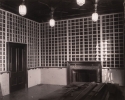
Raymond Schwartz, North-western corner of the Peacock Room during restoration, photograph, 1947, Freer Gallery of Art
After carrying out cleaning tests in 1989, the room underwent major conservation between 1990 and 1992 under the direction of Wendy Samet, with the assistance of Joyce Hill Stoner. Using solvents specially devised by Richard Wolbers, the dense accumulation of dirt, repaint, and yellowed varnish was removed. 17
Notes:
1: Hobbs 1980 [more], p. 13; see Audsley & Bowes 1875 [more], vol. 1, plate L, f. p. 49.
2: Exhibition catalogue London and New York 1960 [more] (cat. no. 118). Exhibition catalogue New York and Philadelphia 1971 [more].
3: Pennington to Heinemann, n.d., Pennell Collection, Library of Congress.
4: MacDonald 1995 (cat. rais.) [more] (cat. no. 1581); Merrill 1998 [more], pp. 297-98.
5: Ibid., pp. 27-28, 193-94. Despite earlier descriptions, the leather is neither Spanish nor from a Tudor house in Norfolk, and its pattern does not show embossed pomegranates; see Williamson 1919 [more], pp. 89-92, Child 1890 [more], at p. 84; Pennell 1921C [more], p. 109; Laver 1930 A [more], pp. 160-161; for the legendary tales of Leyland's leather.
6: [July/August 1876], GUW #12814.
7: Merrill 1998, op. cit, pp. 210-13.
8: Pennell 1908 [more], vol. 1, p. 204.
9: Ibid., p. 206.
10: Quoted in Goupil Gallery 1911 [more]. By 'the screen' he meant Blue and Silver: Screen, with Old Battersea Bridge [YMSM 139].
11: Merrill 1998 [more], pp. 313-16.
12: Merrill 1998, op. cit., p. 348.
13: Ibid., p. 32. Freer Gallery of Art conservation files.
14: Hobbies 1950 [more], quoted in Samet 1990 [more], at p. 7.
15: Samet 1990 [more], at p. 9.
16: Merrill 1998, op. cit., p. 33.
17: See Samet 1990, op. cit., and Merrill 1998, op. cit., p. 34.
Last updated: 20th May 2021 by Margaret

